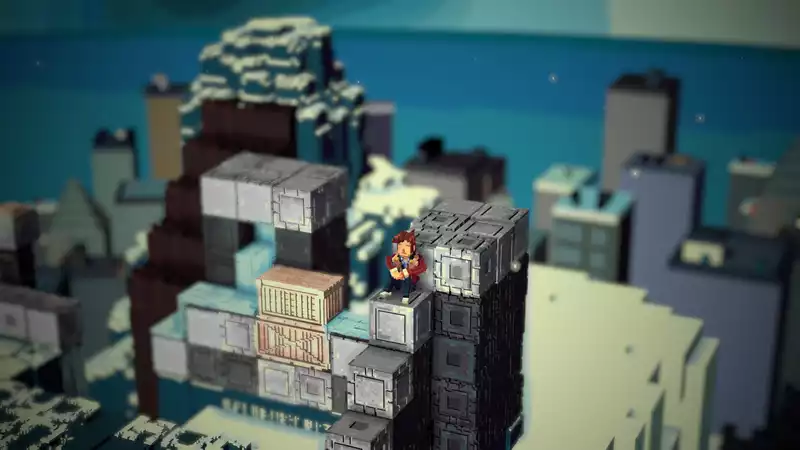Sitting in the snow at the top of Bonfire Peaks, I contemplated the final stage of my journey: failing to complete the game. The puzzles were so tricky that I wanted to pack it all up and move to the forest, but that's as far as I got. Whatever closure the protagonist is trying to achieve by burning all his belongings, he will not achieve it, and neither will I. The unnamed protagonist sets off for the woods to burn his belongings, and it is your job to push, drop, and slide crates full of belongings into the fire. In this blocky voxel world, you can only move forward, backward, and turn in place. Space is key, as the crate (or whatever block you're holding) swings round and round as you rotate. Each of the early puzzles is a simple stage set-up of how to navigate using as much space as necessary.
As Bonfire Peaks progresses, new elements are introduced, including longer bricks, conveyor belt-like flows, and Indiana Jones-like pressure traps. Unlike the smooth onboarding at the start of the game, the introduction of these complex puzzle elements may feel intrusive.
For example, in the case of the long brick, my first encounter was with the overworld bridge. So in the puzzle that immediately followed, I tried to use that idea to build a bridge between myself and the crate. I couldn't quite reach it, so I tried different versions of the same idea over and over again. Finally, he realized that he needed to use bricks to push the crate.
Trying different tactics may seem obvious, but the "Bonfire Peak" puzzle is tricky. Failing a few times is a necessary part of finding the right way. So just because you've built a trashy bridge doesn't mean you shouldn't build one right away.
As you climb through the forested overworld, you will encounter remnants of the life you will probably leave behind. A large calculator and a chunky television set tell you to "burn all your belongings to escape into nature," while other elements suggest that something more tragic might have happened. However, the placement of large, obvious symbols to suggest a narrative feels more on-the-nose than sentimental. When combined with more random assets (such as the inexplicable pile of sliced watermelons at the climax of the game), the effect feels distracting.
Traveling through the forest, one will pass through various biomes, which adds a sense of progression to the overall journey. The man climbing behind the waterfall is definitely different than when he left his car at the bottom of the hill. The music changes subtly, and the soft-focus puzzle background changes from colored leaves, to old buildings, to burning lava. When did it start snowing?" Indeed, it has not been snowing all the time.
There is a story to be told about overcoming puzzles, moving between different areas of the forest, and scrambling to the top of the mountain. By contrast, the scattered meanings feel more like an afterthought, as if the game is worried that players will not be satisfied unless they are told why they are there. Perhaps a little too close to fleeing the country under a different name, but I had already bought into the catharsis on offer.
What worked best was the dedicated "sit" button. The game had a meditative quality to it, and the music faded away as I immersed myself in the puzzle and focused. The character pauses his work and, if there is space, leans back to watch the sky or cower in his lap. The simplicity of the voxel art style adds to its charm.
"Bonfire Peaks'" attention to neither irritating nor condescending contributes to its contemplative feel. You can improve by completing a few puzzles per zone, but more areas will open up as you complete more puzzles. To undo an inadvertent mistake or to capitalize on an "aha" moment, simply tap a button. You can even undo puzzle resets and make up for all the hard work you've put in up to that point. It's a careful balance to keep you in your element.
However, this consideration backfired. As I progressed through the forest, I became more and more aware of things that I clearly did not understand and that were fundamental to the logic of the puzzle. There were quite a few zones where I put aside a significant number of puzzles because I could not find a solution or even a way to experiment with them.
Sometimes, early in the game, a puzzle made no sense at all until I solved another puzzle in the same zone and learned a new "trick". However, as we approached the end of the game, it seemed as if something was fundamentally missing, as if we had not learned how to pick up the box. So when we reached the climax of the game, I found myself unable to complete the puzzle and make the final ascent. Later, when I was taught the solution, it turned out that I had been repeatedly building bad bridges. I had not mastered the endgame mechanics and had simply misread the puzzle.
The individual puzzles in "Bonfire Peaks" are all excellent, and in fact, every part of the puzzle map is used to create precisely the necessary bottlenecks, obtrusive heights, escalating stairs, etc. The worlds are beautiful and incredibly clever for a collection of puzzles. If it weren't for the uneven progression and self-conscious story additions, it wouldn't be such a steep climb.
.

Comments